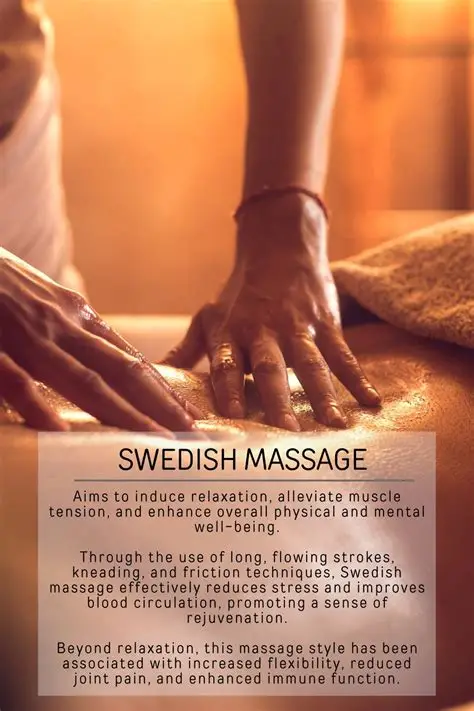A Swedish massage is one of the most common and widely practiced types of therapeutic massage. It’s known for its gentle, relaxing, and flowing techniques, making it ideal for people who are new to massage or simply want to unwind and reduce stress.

Swedish massage typically uses five main strokes:
Health Benefits of a Swedish Massage
Health Benefits of a Swedish Massage Swedish massage
- Effleurage – Long, gliding strokes using the palms, meant to warm up the muscles.
- Petrissage – Kneading, rolling, and squeezing the muscles to release tension and improve circulation.
- Friction – Deep circular movements, often on joints or tight areas, to break up adhesions and release deeper tension.
- Tapotement – Rhythmic tapping or percussion using cupped hands or fingertips (used more selectively).
- Vibration – Gentle shaking or trembling movements to loosen muscles.
Massage oil or lotion is typically used to reduce friction and allow for smooth, continuous strokes Swedish massage
- Promotes relaxation
- Reduces stress and anxiety
- Improves blood circulation and lymph flow
- Eases muscle tension and soreness
- Enhances flexibility and mobility
- Improves sleep quality
- Beginners to massage
- People with general tension or stress
- Those looking for a relaxing experience rather than deep tissue therapy
| Type | Pressure Level | Goal |
|---|---|---|
| Swedish | Light to medium | Relaxation, stress relief |
| Deep Tissue | Firm to deep | Target chronic muscle tension |
| Sports Massage | Variable | Focus on athletic recovery |
| Shiatsu | Finger pressure | Balancing energy flow (Eastern) |
Reduces stress
Calms the nervous system and lowers cortisol (the stress hormone) levelsSwedish massage
Eases anxiety and depression
Promotes a sense of well-being by increasing serotonin and dopamine production.
Improves sleep quality
Encourages relaxation, making it easier to fall asleep and stay asleep.
Boosts mood
The combination of touch, relaxation, and endorphin release can elevate your mood.
Relieves muscle tension and stiffness
Especially in the neck, shoulders, and back.
Improves blood circulation
Helps deliver oxygen and nutrients to muscles and organs more efficiently.
Stimulates the lymphatic system
Supports detoxification by helping remove metabolic waste and toxins.
Increases flexibility and mobility
Gently stretches and loosens muscles and connective tissues.
Reduces fatigue
Promotes physical relaxation and energy recovery.
Speeds up recovery from injury
Enhances tissue healing and reduces soreness post-exercise (when used appropriately).
Enhances immune function
Supports healthy skin through increased blood flow and hydration
Encourages mind-body connection and mindfulness
Swedish massages are generally gentle and safe, with a very low risk of harm. Although rare, risks are not unheard of. There may be some soreness or bruising for a day or two after a massage. You may get a headache if you’re dehydrated and the massage releases toxins. There’s also a chance of having an allergic reaction to an oil or lotion used by the massage therapist.
Massages using strong pressure or intense focus on deep tissues have been known to cause injury to nerves or bones, as well as blood clots.
Avoid getting a massage of any type if you have:
- A fever
- A virus, such as the flu, or other contagious condition
- The blood-clotting disorder hemophilia
- A current flare-up of arthritis, fibromyalgia, or lupus
- Recently had surgery
If you’re pregnant or have a history of high blood pressure or heart disease, talk to your doctor before going for a massage.